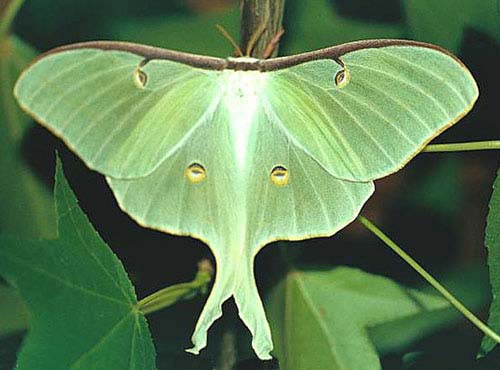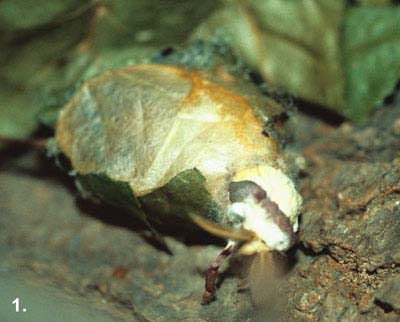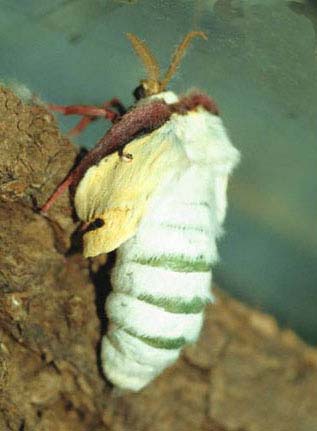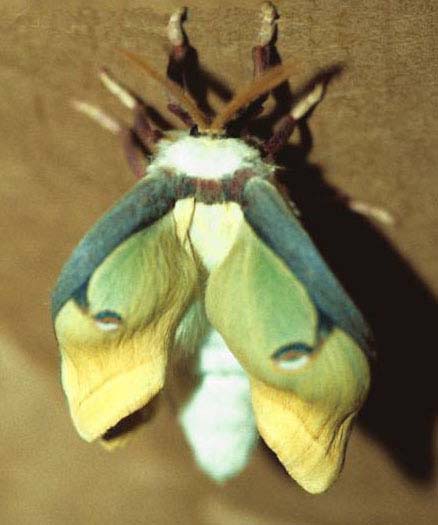Luna moth: Actias luna (Linnaeus, 1758)

Female Actias luna moth on sweetgum courtesy of John H. Campbell.
This site has been created by
Bill Oehlke at oehlkew@islandtelecom.com
Comments, suggestions and/or additional information are welcomed by Bill.
Become a member of
THE WORLD's
LARGEST SATURNIIDAE SITE
Pictures, information, contests, prizes,
data base search engine, free cocoons, special member only privileges
| TAXONOMY:
Superfamily: Bombycoidea Latreille, 1802
Family: Saturniidae Boisduval, [1837] 1834
Subfamily: Saturniinae Boisduval, [1837] 1834
Tribe: Saturniini Boisduval, [1837] 1834
Genus: Actias Leach, 1815
| |
MIDI MUSIC
"Moon River"
copyright C. Odenkirk
MIDI CITYON.OFF
<bgsound src="moon.mid" LOOP=FOREVER>
|
DISTRIBUTON:
The luna moth, Actias luna (wingspan 4.5-5.0 inches), is very common
in many counties of the eastern states from Maine to Florida and generally becomes less plentiful as one moves
westward to Texas and the Great Plains. Lunas are found in many Canadian provinces:
Nova Scotia, P.E.I., New Brunswick, and in southern portions of Quebec, Ontario,
Manitoba, and Saskatchewan.
FLIGHT TIMES AND PREFERRED FOOD PLANTS:
In Canada and the
northern border states within its range, the luna caterpillar shows a preference
for white/paper birch (Betula paperifera), and the moth is usually single brooded with most
adults flying from late May to early July.
In New Jersey and states of that general latitude, caterpillars consume
hickory, walnut, and sweetgum. Double brooded stock first appears from
late April to May with the second brood appearing nine to eleven weeks
later.
In the more southern latitudes, larvae favour persimmon. Adult moths
fly at eight to ten week intervals starting in March, allowing for at least
three broods. Adult Actias luna have been taken in every month in
Louisiana.
Lunas which emerge in the spring often have a red lateral line on
each side of the body and usually have narrow outer red margins on both fore and hind wings.
This red colouration is absent from subsequent broods.
ECLOSION:
Adults usually eclose from their cocoons in
mid morning. The
cocoon is rather flimsy and valveless. The moth makes quite
a racket as it heaves itself against one end of the cocoon, tearing at the
silk with hornlike projections near the base of the forewing. A secretion
called cocoonase helps to break down the sericin binding the silk.
| 
Photo courtesy John H. Campbell |
The emerging male
(note antennae develoment above) struggles to extricate himself. In a process that seldom
takes more than five minutes, the young moth softens, tears, and frees itself from its cocoon.

| The soft moth (female to left, note narrow antennae) can escape through a hole roughly 3/8 inch in diameter. Once
out of the cocoon, the moth must climb to hang its wings for inflation.
I place my luna
cocoons in a 11" x11" x 2' emerging cage made out of folded hardware cloth with a 1/2 inch mesh.
The newly emerged, soft, pliant moths climb up the wire and hang from either the top or upper
reaches of the sides.
Photo courtesy of John H.
Campbell |
One of the most beautiful natural sights I ever witnessed as a young
boy occurred one May morning when I chased an errant baseball into a mature hickory stand in New Jersey.
Sunlight streamed through small openings in the leafy canopy onto lush ground foliage on the forest floor.
A fully expanded, freshly emerged luna hung about one foot from the ground on the underside of a
skunk cabbage stem.
Despite having witnessed hundreds of eclosions in my lifetime, I still often
pause to watch lunas eclose and inflate in emergence cages. All of the giant Saturniidae pump fluid into veins
in soft stubbly wings while hanging from stems, tree trunks, etc.
Photo courtesy of John H. Campbell.
The adult Saturniidae moths have no mouth parts or feeding tubes.
The moths live for 7-10 days as adults,
utilizing fats stored from caterpillar days.
| 
|
The entire process seldom takes more than half an hour, and
in another few hours the fully inflated wings have stiffened in preparation for flight.
Even the giant atlas ecloses with wing stubs seldom more than one inch long.
SCENTING AND MATING:
At approximately 10:30 pm (as early as 9:00 pm in early spring) the female moth extends a scent gland from the
posterior of her abdomen
and begins releasing an air borne pheromone. This scent attracts the male.
Once coupled,
the pair will remain that way until the following evening. In captivity
siblings will mate
readily, even in a small cage. Wild males are easily attracted. Scenting or "calling" usually
continues until around 1:00 am or until the female has mated, whichever
comes first.
Males usually emerge a day or two before females
and it is rare that an unmated female would be captured at a light as
females usually don't fly until after mating.
EGGS, CATERPILLARS, COCOONS, AND PUPAE:
Gravid female moths lay 4-6 gray-brown cylindrical eggs with concave tops on
the underside of food plant leaves. Females have a capacity of 150-250 eggs.
Incubation time is 8-13 days depending on temperature and humidity.
Females readily deposit eggs in inflated brown paper sandwich or grocery
bags for those who wish to rear this species.
Caterpillars, which grow to
approximately 3.5 inches (9 cm.), are predominantly green throughout their
five instars and spend roughly one week in each stage except the longer
fifth instar. Larvae which are going to overwinter in the pupae/cocoon
stage take on a dark amber or burgundy-brown colouration just prior to
spinning cocoons.
Some caterpillars will use a leaf wrap while others
descend to spin up among whatever ground protection they can find.
Mature larvae "clear their guts" with a loose, runny stool just
prior to cocooning.
Luna cocoons are papery thin and pupae outlines can
easily be seen when the cocoon is held up to a bright light. Winter
diapause stock tends to spin a courser, darker silk. In regions of the
United States where lunas are double or triple brooded 25-40% of early
brood stock caterpillars will spin the darker cocoon and overwinter instead of eclosing
that same summer.
I store my winter diapause stock in small (sandwich sized),
tightly-lidded containers (no air holes) holding 10-20 cocoons each in the refrigerator
crisper. I have not had problems with dessication even though I do not
mist the cocoons. Cocoons may also be stored outdoors in a more natural
environment in protective cages.
The pupae are dark brown and the
antennae outline can be seen on the pupal shell to determine sexes.
Click on food plant information to see
a caterpillar image and a listing of foodplants.
Return to Homepage



